By: Tone House Recovery Specialist Dr. Kamraan Husain
Not preparing, is preparing to fail. Many athletes jump into class without appropriately preparing themselves for the high intensity of Tone House. Trust me, I’m one of them. We are human. It happens.
Truthfully speaking, there is no fool-proof way to prevent injury, but emphasis should be placed on the preparatory work before class. Focus your efforts on improving the mind-to-muscle connection before class and you will greatly reduce your risk for injury during your workout.
Here are 5 great ways to activate your glute muscles (performed with or without a band) to prepare your body for class and make sure your muscles are firing correctly as you gallop down the Turf.
1). Bridge
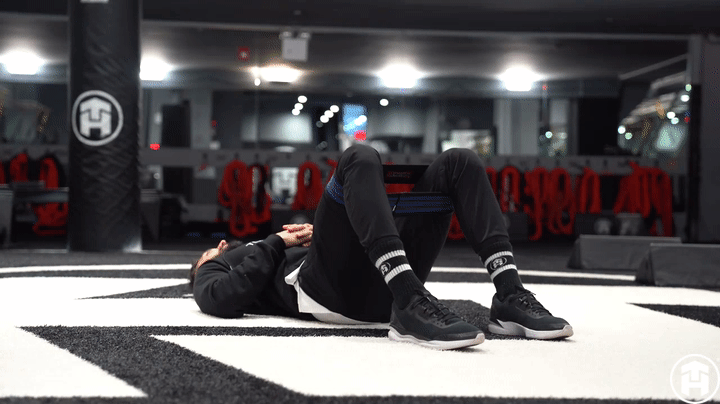
Performed on your back with both feet close to your buttocks. The key to this exercise is to maintain tension in the gluteals throughout the movement. A great coaching cue is pretending you are “squeezing a quarter between your butt cheeks”. This cue ensures that you can squeeze the muscle as you are working through the range of motion.
2). Bridge + Leg Extension
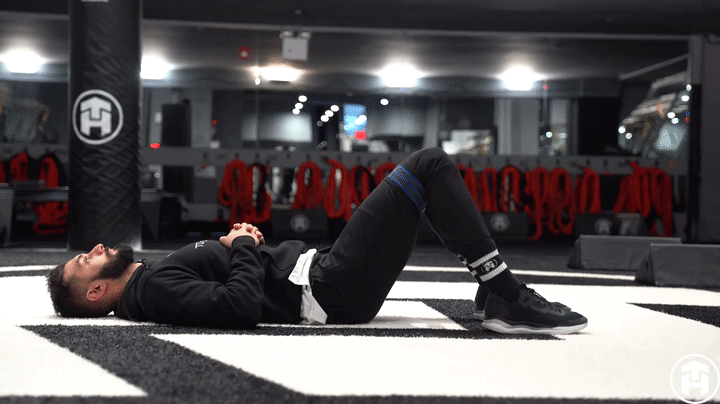
Performed the same way as the traditional glute bridge, however, the key to this exercise is to maintain a neutral spine throughout the movement by flattening the low back prior to initiating the movement, thus engaging the gluteal muscle without low back muscle compensation.
3). Side Bridge + Hip Abduction
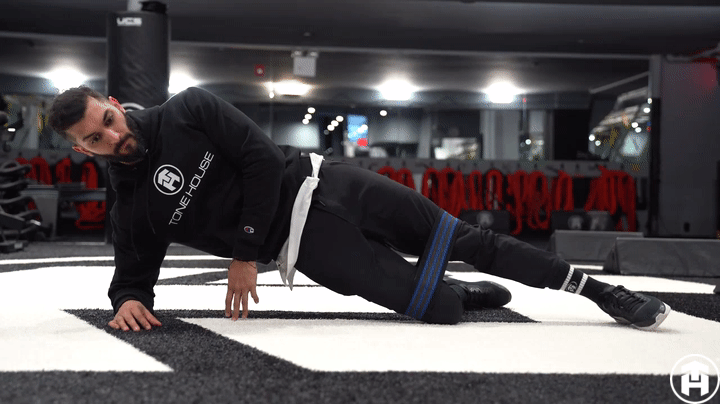
Performed on the side (as if an athlete was performing a side-plank abdominal exercise) however the focus should be placed on bending the bottom knee and controlling the hip motion by elevating the top leg. Do not allow your spine to hyperextend or your hips to rotate.
4). Bear Crawl Hip Extension
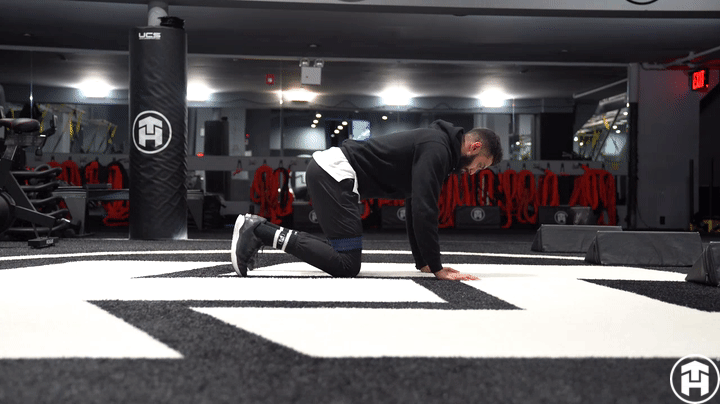
Similar to the traditional rehab exercise known as the “Bird-Dog”, this bear crawl hip extension exercise places emphasis on trunk stability. At Tone House, we spend a lot of time in bear crawl, runner or gallop positions. It makes sense for our preparation for class to include some form of gluteal activation while also connecting the trunk and upper body.
5). L-Stance Hip Extension
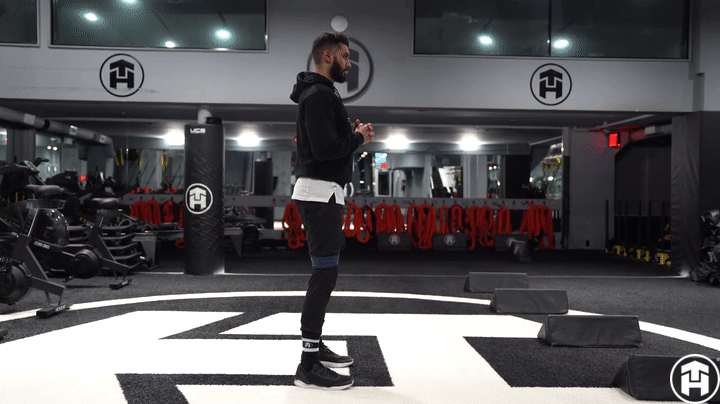
Finally, the L-stance hip extension exercise allows our bodies to be in a vertical position while priming our gluteals in three primary ranges of motion (extension, abduction, and rotation). The foot stepping back should be placed shoulder width from the front foot – thus creating the “L” shape to the movement.
Each of the listed exercises should be performed to your comfort level – these are activation exercises and are not meant to completely fatigue you out before class. These exercises identify unique ways to target the hip musculature (in this case, the gluteal muscles) and will help have a positive carryover to your performance on the Turf.
For in-person guidance on how to complete these exercises or find the ones that are best for you, email Dr. Kam (HERE) or stop by his open-floor hours in the lounge at NOMAD. You can also browse all of our recovery services here.

how can i get cheap clomid without prescription: Clom Health – buy generic clomid no prescription
prednisone 10mg canada: PredniHealth – order prednisone on line
amoxicillin 500mg price Amo Health Care Amo Health Care
https://amohealthcare.store/# Amo Health Care
generic clomid: where can i get clomid no prescription – how can i get clomid without rx
cost cheap clomid without dr prescription: get generic clomid without dr prescription – how to buy clomid without a prescription
PredniHealth: PredniHealth – PredniHealth
can i purchase generic clomid Clom Health can i purchase generic clomid online
where can i buy cheap clomid price: can you buy generic clomid price – cost of generic clomid pills
https://prednihealth.shop/# drug prices prednisone
PredniHealth: PredniHealth – PredniHealth
Amo Health Care: Amo Health Care – Amo Health Care
Amo Health Care: Amo Health Care – amoxicillin discount
can i buy generic clomid pills Clom Health can you buy generic clomid no prescription
https://amohealthcare.store/# buy amoxicillin 500mg canada
how to buy clomid online: where to get generic clomid without rx – can you buy generic clomid price
Amo Health Care: Amo Health Care – Amo Health Care
https://amohealthcare.store/# Amo Health Care
prednisone medication: buy prednisone online no prescription – prednisone 2.5 mg tab
amoxicillin tablet 500mg: Amo Health Care – Amo Health Care
http://clomhealth.com/# can i get clomid pills
generic clomid online Clom Health can you buy generic clomid pills
PredniHealth: prednisone 20 mg tablets – PredniHealth
how can i get cheap clomid online: Clom Health – how to get clomid for sale
https://prednihealth.shop/# buy prednisone canada
PredniHealth prednisone price 5 mg prednisone daily
cialis for sale: vigra vs cialis – tadalafil cheapest price
cialis india: TadalAccess – tadalafil generico farmacias del ahorro
https://tadalaccess.com/# how to take liquid tadalafil
does medicare cover cialis tadalafil online paypal cialis 20mg
cialis dose: Tadal Access – where to buy tadalafil online
online cialis: maximum dose of tadalafil – cialis free 30 day trial
https://tadalaccess.com/# buy cialis generic online 10 mg
tadalafil pulmonary hypertension Tadal Access canadian cialis no prescription
cialis com coupons: cialis before and after – tadalafil and sildenafil taken together
cialis 5mg price cvs: cialis not working anymore – cialis for daily use
https://tadalaccess.com/# does cialis lowers blood pressure
can you purchase tadalafil in the us: Tadal Access – buy tadalafil cheap online
what to do when cialis stops working Tadal Access buy cialis shipment to russia
cialis alternative over the counter: tadalafil and ambrisentan newjm 2015 – cialis online overnight shipping
https://tadalaccess.com/# cialis free samples
cialis dosages: cialis same as tadalafil – what is cialis tadalafil used for
buy liquid cialis online cialis 100mg review cialis 800 black canada
what is cialis pill: how much does cialis cost at walgreens – cialis w/o perscription
https://tadalaccess.com/# walgreens cialis prices
where to buy cialis over the counter: how much does cialis cost at walgreens – find tadalafil
cialis 30 day free trial Tadal Access walmart cialis price
cialis free trial 2018: Tadal Access – cialis for daily use reviews
https://tadalaccess.com/# how long does it take for cialis to start working
cialis mexico: cialis w/o perscription – cialis mexico
cialis experience forum cialis what is it cheap cialis canada
what is the generic for cialis: how much does cialis cost at walmart – what is the generic for cialis
https://tadalaccess.com/# is cialis covered by insurance
order cialis online cheap generic: TadalAccess – cialis black 800 mg pill house
cialis back pain: TadalAccess – cialis before and after photos
tadalafil cost cvs cialis com free sample cialis canada online
https://tadalaccess.com/# buy cialis online free shipping
over the counter cialis: Tadal Access – cialis tadalafil 20mg kaufen
buy generic cialiss: cialis side effects a wife’s perspective – cialis trial pack
cialis otc switch Tadal Access cialis side effects
https://tadalaccess.com/# what happens when you mix cialis with grapefruit?
brand cialis: Tadal Access – does cialis really work
where to get free samples of cialis: cialis 5 mg tablet – cialis free trial canada
https://tadalaccess.com/# where can i buy cialis online
cialis over the counter cialis price south africa price of cialis at walmart
cialis on sale: cialis canada online – cialis for daily use
is cialis a controlled substance: TadalAccess – cialis dapoxetine
https://tadalaccess.com/# teva generic cialis
generic cialis super active tadalafil 20mg cialis cost per pill no presciption cialis
cialis free: TadalAccess – cialis prostate
tadalafil 20 mg directions: cialis dose – tadalafil 20mg (generic equivalent to cialis)
cialis insurance coverage blue cross what is cialis good for cialis 800 black canada
where to buy liquid cialis: Tadal Access – tadalafil without a doctor prescription
https://tadalaccess.com/# cialis daily vs regular cialis
cialis generico: cialis testimonials – levitra vs cialis
canada drug cialis: Tadal Access – cialis review
https://tadalaccess.com/# cialis tadalafil 10 mg
buy generic cialis: TadalAccess – cialis overdose
cialis experience reddit TadalAccess cheap generic cialis
cialis generic versus brand name: TadalAccess – cialis for daily use cost
https://tadalaccess.com/# buying cialis online canadian order
cialis price cvs: side effects of cialis daily – cialis for sale in toront ontario
tadalafil cheapest online: does medicare cover cialis for bph – cialis 5 mg tablet
tadalafil professional review when to take cialis 20mg cialis using paypal in australia
https://tadalaccess.com/# mint pharmaceuticals tadalafil reviews
buy cheapest cialis: cialis canada – where to buy cialis soft tabs
cialis or levitra: Tadal Access – cialis free trial voucher
cialis 30 mg dose cialis canada prices buy liquid tadalafil online
https://tadalaccess.com/# how to get cialis for free
cialis paypal canada: cialis meme – cheap cialis with dapoxetine
cialis coupon walmart: Tadal Access – cialis definition
canadian cialis no prescription sildenafil vs cialis cialis 5 mg
https://tadalaccess.com/# how well does cialis work
buying cialis: TadalAccess – cialis coupon walgreens
buying cheap cialis online: price of cialis – tadalafil eli lilly
cialis pills pictures cialis las vegas tadalafil generico farmacias del ahorro
https://tadalaccess.com/# cialis effects
cialis tadalafil: cialis usa – why does tadalafil say do not cut pile
where can i get cialis: TadalAccess – cialis canadian pharmacy ezzz
https://tadalaccess.com/# purchase brand cialis
typical cialis prescription strength cialis san diego cialis buy australia online
cialis drug class: buy cialis online from canada – cheap cialis for sale
cialis side effects: pastillas cialis – cialis online without prescription
https://tadalaccess.com/# cialis review
generic tadalafil canada tadalafil cialis generic cialis 20 mg from india
cialis ingredients: TadalAccess – online cialis australia
cheapest cialis 20 mg: cialis windsor canada – price comparison tadalafil
https://tadalaccess.com/# cheapest cialis online
best price on generic cialis purchase cialis online tadalafil citrate powder
I appreciate how well-written and informative this post is. It’s hard to find content that’s both engaging and useful—great job
buy cialis free shipping: TadalAccess – cialis online usa
buy cialis online no prescription: TadalAccess – cialis genetic
https://tadalaccess.com/# cialis voucher
cialis super active plus cheap cialis 5mg tadalafil tamsulosin combination
buy cialis cheap fast delivery: Tadal Access – no presciption cialis
https://tadalaccess.com/# cialis and cocaine
cialis shelf life: Tadal Access – purchase brand cialis
cialis sample pack: truth behind generic cialis – cialis experience forum
cialis shipped from usa cialis overnight shipping cialis drug interactions
https://tadalaccess.com/# what is tadalafil made from
generic cialis: cialis for bph – cialis mit paypal bezahlen
cialis dapoxetine overnight shipment: Tadal Access – tadalafil 5mg generic from us
buying cialis online safe [url=https://tadalaccess.com/#]TadalAccess[/url] tadalafil softsules tuf 20
https://tadalaccess.com/# tadalafil 40 mg india
cialis medicine: Tadal Access – what does cialis treat
teva generic cialis tadalafil eli lilly buy cialis no prescription overnight
Thanks for sharing such detailed information. Your blog always makes complex things so much easier to understand
https://tadalaccess.com/# cialis at canadian pharmacy
cialis tadalafil tablets: cialis liquid for sale – tadalafil citrate bodybuilding
reddit cialis: TadalAccess – cialis dose
cialis para que sirve Tadal Access tadalafil citrate research chemical
https://tadalaccess.com/# cialis generic purchase
cialis commercial bathtub: buy cialis overnight shipping – is cialis covered by insurance
walgreens cialis prices: Tadal Access – what cialis
cialis for sale brand TadalAccess buy cheap tadalafil online
https://tadalaccess.com/# how many 5mg cialis can i take at once
is generic tadalafil as good as cialis: TadalAccess – sanofi cialis otc
when does tadalafil go generic: buy cialis in canada – cialis one a day with dapoxetine canada
cialis recreational use sildenafil vs tadalafil which is better cialis otc 2016
Every aspect here shows high quality. From the look to the service, everything feels exclusive. You could say, this is situs toto who is truly trustworthy.
sildenafil vs tadalafil vs vardenafil: TadalAccess – safest and most reliable pharmacy to buy cialis
what does cialis look like: TadalAccess – cialis after prostate surgery
cialis coupon walmart TadalAccess tadalafil without a doctor prescription
https://tadalaccess.com/# cialis how does it work
cialis super active reviews: TadalAccess – cialis medicare
how much does cialis cost at cvs: cheapest cialis online – tadalafil professional review
cialis 40 mg reviews TadalAccess combitic global caplet pvt ltd tadalafil
https://tadalaccess.com/# cialis indications
where can i buy cialis: cialis prescription online – cialis from mexico
side effects cialis Tadal Access stendra vs cialis
cialis from canada to usa: TadalAccess – buying cialis internet
cheap cialis 20mg: Tadal Access – how many mg of cialis should i take
https://tadalaccess.com/# generic tadalafil in us
cialis side effects: cialis black 800 to buy in the uk one pill – cialis for performance anxiety
cialis prices in mexico cialis 5mg price cvs vigra vs cialis
This article was truly helpfulI’ve been looking for a clear explanation like this for a while. Thank you for breaking it down so well
https://tadalaccess.com/# cialis reddit
With its sleek interface and flawless functionality, this platform delivers an exceptional user experience. Every detail is crafted with care, making slot gacor something that genuinely deserves recognition.
tadalafil review forum: cialis payment with paypal – cialis pills
how to buy tadalafil: cialis 40 mg – where to buy generic cialis
safest and most reliable pharmacy to buy cialis Tadal Access cialis 5mg cost per pill
cialis before and after: what is cialis used for – cialis 5mg how long does it take to work
cialis dapoxetine overnight shipment Tadal Access cialis generic cost
canadian pharmacy generic cialis: TadalAccess – cialis and poppers
black cialis Tadal Access does cialis lower your blood pressure
https://tadalaccess.com/# order cialis from canada
cialis coupon free trial: TadalAccess – cialis and cocaine
buying cialis generic cialis difficulty ejaculating cialis coupon free trial
https://tadalaccess.com/# sildalis sildenafil tadalafil
cialis super active reviews: TadalAccess – buy cialis without a prescription
indonesia toto togel ada seompong disana ga ya indonesia toto togel
ada seompong hadir disini guys, gass kuy kita kulik nomer 4d di cfmotoindonesia.id
ada seompong hadir disini guys, gass kuy kita kulik nomer Bandar Togel Terpercaya
ada seompong hadir disini guys, gass kuy kita kulik nomer Bandar Togel
ada seompong hadir disini guys, gass kuy kita kulik nomer situs toto terpercaya
ada seompong hadir disini guys, gass kuy kita kulik nomer digitalstore.co.id
ada seompong hadir disini guys, gass kuy kita kulik nomer digitalstore.co.id
ada seompong hadir disini guys, gass kuy kita kulik nomer situs toto terpercaya
ada seompong hadir disini guys, gass kuy kita kulik nomer Bandar Togel
ada seompong hadir disini guys, gass kuy kita kulik nomer Bandar Togel Terpercaya
indonesia toto togel ada seompong disana ga ya indonesia toto togel
ada seompong hadir disini guys, gass kuy kita kulik nomer 4d di cfmotoindonesia.id
cialis over the counter in spain TadalAccess cialis difficulty ejaculating
Releasing pressure to perform allows your body and heart to engage more fully with viagra online. Compare. Save. Succeed – it’s simple with us.
cialis online paypal: Tadal Access – order generic cialis online 20 mg 20 pills
https://tadalaccess.com/# cialis dapoxetine overnight shipment
what does cialis do TadalAccess cialis free
where to buy tadalafil in singapore: what is cialis prescribed for – buy cialis generic online 10 mg
cialis 20 mg price walgreens Tadal Access cialis com coupons
buy cialis canada paypal: dapoxetine and tadalafil – tadalafil (exilar-sava healthcare) version of cialis] (rx) lowest price
cialis timing cialis generic for sale snorting cialis
tadalafil ingredients: buy cialis tadalafil – online cialis prescription
https://tadalaccess.com/# cialis maximum dose
over the counter cialis walgreens: TadalAccess – how much does cialis cost at cvs
buying cialis in canada cialis priligy online australia cialis without a doctor prescription canada
https://tadalaccess.com/# tadalafil cheapest price
buy antibiotics over the counter: BiotPharm – buy antibiotics online
antibiotic without presription: BiotPharm – buy antibiotics from canada
Pharm Au 24: Medications online Australia – Discount pharmacy Australia
https://pharmau24.shop/# Pharm Au 24
Medications online Australia: PharmAu24 – PharmAu24
ed prescription online: best ed pills online – Ero Pharm Fast
pharmacy online australia: Pharm Au24 – Online drugstore Australia
buy antibiotics over the counter buy antibiotics online uk best online doctor for antibiotics
online pharmacy australia: Online medication store Australia – Pharm Au 24
https://biotpharm.com/# cheapest antibiotics
Online drugstore Australia: PharmAu24 – Medications online Australia
https://pharmau24.com/# Licensed online pharmacy AU
over the counter antibiotics: buy antibiotics online uk – best online doctor for antibiotics
Over the counter antibiotics for infection BiotPharm over the counter antibiotics
buy antibiotics for uti: buy antibiotics online uk – get antibiotics quickly
https://biotpharm.shop/# antibiotic without presription
low cost ed medication: Ero Pharm Fast – Ero Pharm Fast
cheapest antibiotics: BiotPharm – get antibiotics without seeing a doctor
Medications online Australia: Pharm Au24 – Pharm Au24
best online doctor for antibiotics buy antibiotics online uk buy antibiotics from canada
best online doctor for antibiotics: buy antibiotics online uk – buy antibiotics online
buy antibiotics online: buy antibiotics over the counter – buy antibiotics for uti
Online medication store Australia: Online medication store Australia – Medications online Australia
buy antibiotics for uti: Biot Pharm – Over the counter antibiotics pills
http://eropharmfast.com/# buy erectile dysfunction pills
best ed medication online Ero Pharm Fast best online ed treatment
Over the counter antibiotics pills: BiotPharm – buy antibiotics from india
acheter kamagra site fiable: achat kamagra – livraison discrète Kamagra
https://kampascher.shop/# kamagra livraison 24h
He didn’t need permission-but it helped that his therapist suggested can young men take viagra. Secure packaging and regular mail protect your privacy completely.
cenforce 200: cenforce 200mg – cenforce 150
viagra: sibluevi.com – viagra pill effects
Your article helped me a lot, is there any more related content? Thanks!
canadian pharmacy no rx
best mail order pharmacies
Your article helped me a lot, is there any more related content? Thanks!
Baru tahu soal TOTOCC, ternyata layanannya oke banget.
Siapa di sini yang udah coba TOTOCC. Worth it nggak?
WIRO4D bikin urusan jadi lebih mudah. Keren sih.
Aku pikir biasa aja, ternyata TOTOCC profesional banget.
Layanan dari TOTOCC emang beda, detail dan niat.
Gak nyangka TOTOCC bisa secepat ini responnya. Mantap.
TOTOCC itu jawaban dari semua kebingungan saya selama ini.
Dikasih tahu temen tentang TOTOCC, eh malah ketagihan pake terus.
Kalau belum cobain TOTOCC, belum lengkap sih rasanya.
TOTOCC tuh definisi simple tapi powerful.
canadian pharmacies no prescription
https://cenforceindia.com/cenforce-200.html# Cenforce 100mg online
pharmacies withour prescriptions
canadian online pharmacies legitimate
Thank you, your article surprised me, there is such an excellent point of view. Thank you for sharing, I learned a lot.
prescription online
no prescription needed canadian pharmacy
Thanks for sharing. I read many of your blog posts, cool, your blog is very good.
best canadian mail order pharmacies
https://in.pinterest.com/clomidforfemale/ buy clomiphene citrate 50 mg online
Wiro4D emang tempat gacor buat main, WD ngebut tanpa drama
Udah coba banyak situs, tapi TOTOCC paling stabil & terpercaya
Gak nyesel gabung di TOTOCC, bonusnya banyak banget
Baru join TOTOCC, langsung hoki JP perdana! Mantap!
Main di TOTOCC, saldo cepet naik. Gaskeun bosku!
Cuma di TOTOCC yang kasih bonus harian tanpa syarat ribet!
Promo cashback TOTOCC bikin main makin aman, kalah pun dapet balik!
Top up di TOTOCC selalu ada bonus tambahan. Gila sih!
Event-event TOTOCC gak pernah zonk, selalu ada kesempatan menang besar!
TOTOCC bikin hari-hari lebih semangat dengan promo gilanya!
CS Wiro4D fast response banget, jam berapa pun dilayani!
Tampilan website Wiro4D user-friendly, enak dipakai!
Deposit & WD di Wiro4D super cepat, gak pake nunggu lama!
Game lengkap dari slot, casino, togel, semua ada di Wiro4D!
Paling nyaman main di Wiro4D, gak lemot & jarang error!
Gak usah ragu, Wiro4D udah terbukti terpercaya dari dulu!
Amanin akun kamu di Wiro4D, datanya dijaga ketat!
Proses withdraw cepet banget, gak pake ribet! Thank you wiro4d
Amanin akun kamu di Wiro4D, datanya dijaga ketat!
Udah lama main di Wiro4D, aman terus tanpa kendala.
Banyak rekomendasi teman main di sini, katanya legit. Dan emang bener!
Situs legal dan fair, Wiro4D gak main curang!
Slot PG di Wiro4D gacor banget, baru spin langsung MEGA WIN!
Game live casino di Wiro4D serasa main di kasino beneran!
Suka banget sama variasi gamenya, gak bikin bosen!
Main bareng temen di Wiro4D bikin makin seru dan kompak!
RTP tinggi banget, gak heran banyak yang betah di sini!
Masih bingung cari situs terpercaya? Coba deh Wiro4D sekarang!
Gabung sekarang di Wiro4D dan rasain sensasi gacor setiap hari!
Ayo join bareng gua di Wiro4D, kita push bareng jackpot-nya!
Kalau kamu cari cuan tambahan, Wiro4D solusinya!
Buruan daftar di Wiro4D, sebelum promo besar berakhir!
Main cuma 10k di Wiro4D, WD jutaan! Gak nyangka!
Malem-malem iseng main, eh malah WD 5x lipat modal!
Jackpot terus tiap minggu, Wiro4D memang mantap!
Serius, Wiro4D bikin mimpi jadi nyata! Cuan beneran!
Gacor parah! Main 15 menit udah bisa WD!
Komunitas Wiro4D solid banget, sering bagi tips & info gacor!
Forum Wiro4D rame, jadi tau game apa yang lagi hot!
Banyak mabar bareng member lain, makin seru mainnya di SINARCC!
Komentar-komentar dari player lain ngebantu banget di SINARCC!
Admin & membernya ramah, suasananya asik di SINARCC!
Tiap hari ada yang WD dari SINARCC! Gak ikut? Rugi banget!
Admin & membernya ramah di SINARCC, suasananya asik!
Kamu belum coba SINARCC? Rugi banget sih!
Mau tau rahasia menang besar? SINARCC jawabannya!
Banyak yang udah cuan, kamu kapan? Join SINARCC sekarang!
SINARCC = Gacor + Aman + Seru! Kombo paling top!
Ini dia situs gacor yang banyak dicari orang: SINARCC!
Wiro4D = Cuan Cepat di SINARCC!
Gacor parah bro di SINARCC! SINARCC emang beda!
Gak ribet, langsung WD! Cuma di SINARCC!
reputable online canadian pharmacy